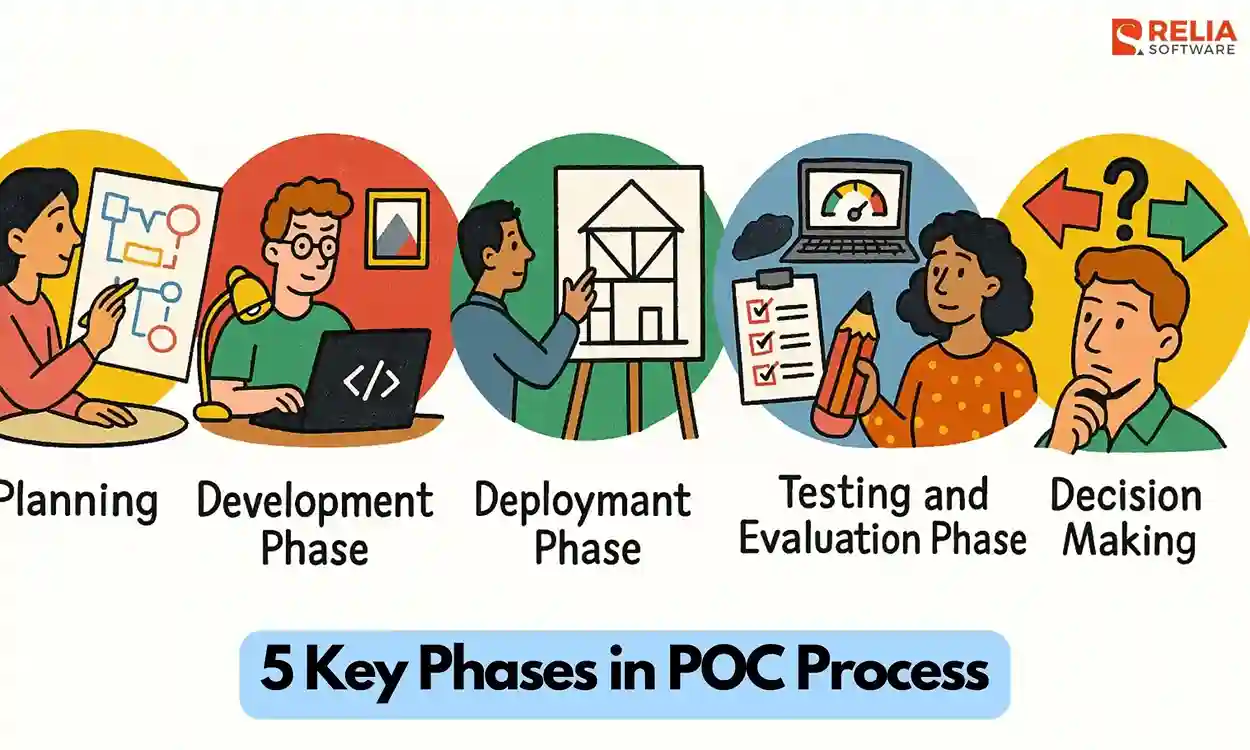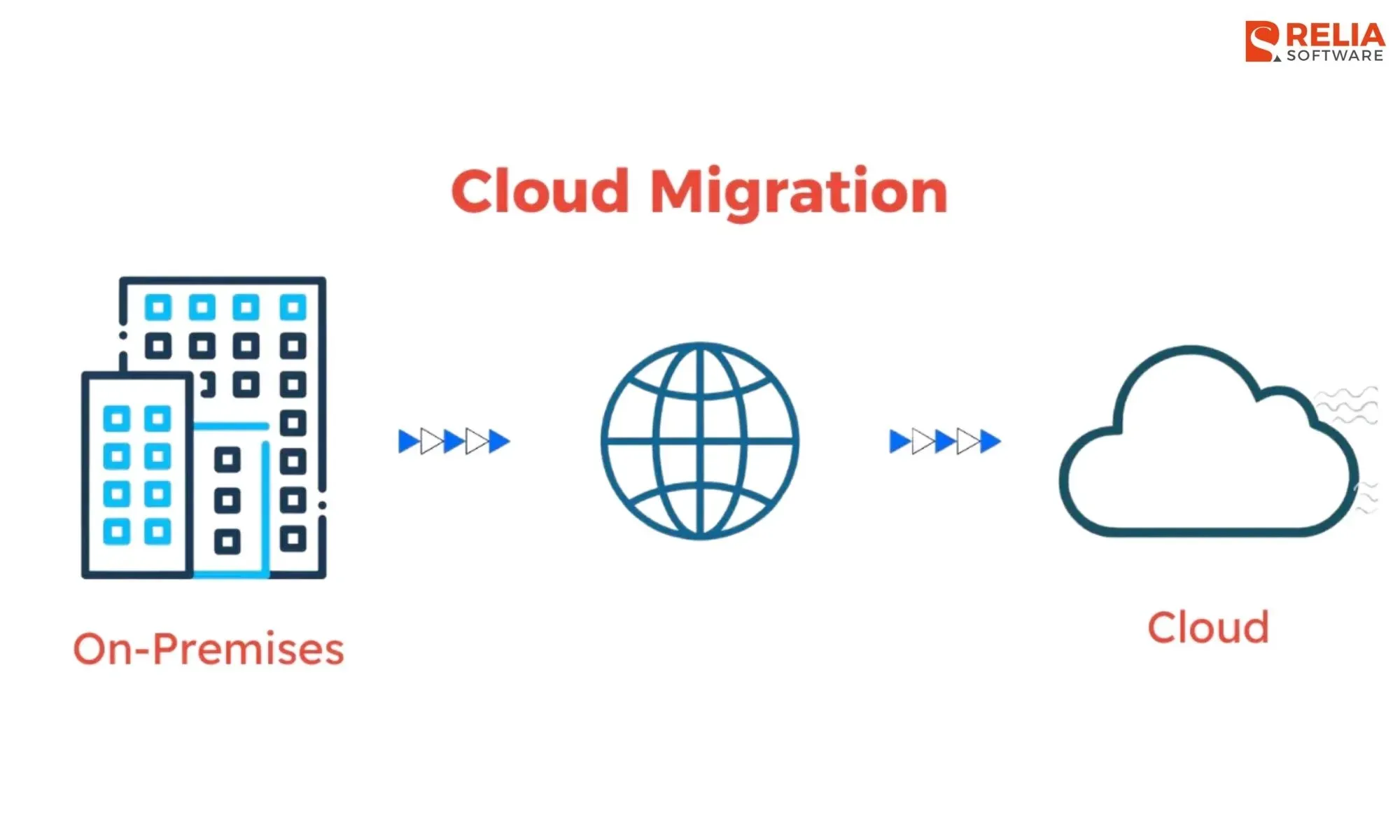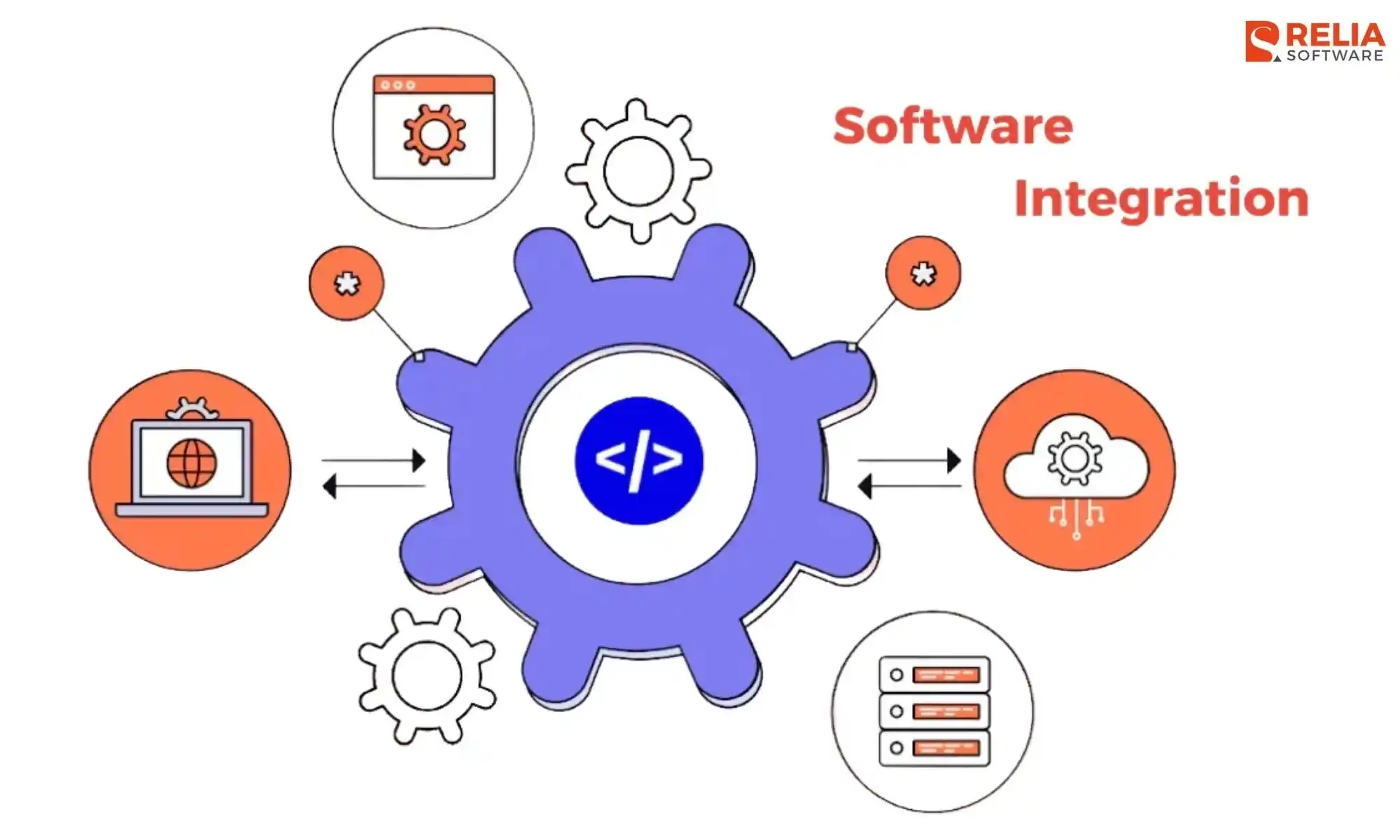Have you ever had a great idea but questioned if it would be practical to use? A Proof of Concept (POC) is helpful at this point. This is a great way to find out if your idea can work before you put a lot of money into it.
This blog will include a comprehensive analysis of proofs of concept. We'll walk you through the process step-by-step and look at real-life examples to help you get past problems and figure out how successful you were. This article will help you, regardless of your position—developer, project manager, business professional—how to apply proofs of concept to execute your special ideas.
>> Read more:
- MVP in Software Development: A Proven Path to Market Success
- Prototype Model in Software Engineering: Types, Phases, Use Cases
What is A Proof of Concept?
Proof of Concept (POC) is a low-risk example that checks whether an idea or software solution can work. Before spending a lot of money on full-scale development, this is basically a test run to see if your idea is useful and can work in the real world.
Think about a POC as an early draft of your idea. It focuses on showing how the core features work to see if the main idea works. Consider it as the building's skeleton. Although it has the basic structure, it lacks the finishing touches like fancy windows, a nice paint job, etc.
For testing contexts, POCs are made to be the bare minimum versions that work. They might lack some features, a refined user interface, or the wide range of capabilities found in the finished work.
A POC project has as its major objectives:
- Show Function: A POC proves your idea works and meets your goals.
- Find Problems: This process identifies early technical, resource, and user experience issues.
- Users' Feedback: Proofs of concept might assist you in improving your idea by gathering user feedback.
- Make a Decision: The POC can assist you in determining whether to develop, revise the answer, or abandon it.

Benefits of POC in Software Development
A POC brings many helpful benefits, especially when you’re working on a new idea or trying out a technology for the first time. It’s a smart way to test things early and avoid mistakes later. Here’s why many software teams use a POC before building the full product:
- Early Check: A POC helps you see if your idea can actually work. It shows whether your plan is possible before spending a lot of time and money on full development.
- Avoiding Problems: By testing early, you can find issues like tools not working well together, slow performance, or setup problems. Fixing these early is much easier than dealing with them later.
- Saving Costs: A POC doesn’t need a big budget. You can test your idea on a smaller scale and only move forward if it proves to be useful. This helps avoid spending money on ideas that won’t work.
- Quick Feedback: A POC is built around just the main idea, so it can be done quickly. This lets your team or a few users try it and give feedback fast. You can use that feedback to make improvements right away.
- Getting Support: It’s easier to get approval or funding when you can show something real. A working POC helps explain your idea clearly and shows that it’s worth building.
- Team Understanding: A POC helps everyone on the team understand the idea in the same way. It gives developers, product managers, and business leaders a shared view, which helps them work better together.
Key Components of A Quality POC
Clear Objective
Every POC should start with a clear goal. What exactly are you trying to test or prove? Whether it's technical feasibility, performance benchmarks, or integration compatibility, defining the objective keeps the POC focused and purposeful.
Minimal Feature Set
Only include the features that are absolutely necessary to demonstrate the core idea. A POC is not about polish or completeness—it’s about function. Leave out anything that doesn’t directly help you validate the main concept.
Defined Success Metrics
Set specific criteria for what success looks like. This could be response time, system stability, ease of use, or something else, depending on your goal. Having measurable metrics makes evaluation easier and more objective.
Basic Interface
Even if the design isn’t final, a basic user interface or workflow helps users understand how the concept works. This can improve the accuracy of feedback and make the POC easier to test.
Realistic Testing Environment
Try to test the POC in a setup that’s similar to the actual environment it would run in. This helps uncover real-world challenges like integration issues, security concerns, or performance limits.
Documentation and Feedback Loop
Track what was tested, what worked, and what didn’t. Collect feedback from testers or stakeholders, and document any lessons learned. This information is key when deciding the next steps or refining the idea.
5 Key Phases in The Proof Of Concept Process
Planning Phase
- Identifying the Need: What problem are you trying to solve or what opportunity are you trying to seize? Clearly define the purpose of your POC to ensure it's aligned with your overall goals.
- Stakeholder Assembly: Who needs to be involved in the POC process? Identify key stakeholders like project managers, developers, and potential end-users. Ensure everyone is aligned on the goals and expectations.
- Criteria for Success Measurement: Set clear and measurable success metrics that are relevant to your goals (e.g., cost savings, efficiency improvement, user satisfaction).
- Resource Allocation: What resources are needed to develop and test the POC (budget, time, personnel)? Be realistic about resource limitations and plan accordingly.
- Tools and Technology: Choose the right tools based on budget, complexity, and technical expertise.
Development Phase
- Focus on core functionality; avoid getting bogged down in non-essential features. Develop a simple but functional version that demonstrates the key concept.
- Implement basic quality assurance procedures to ensure the POC functions as intended. This can involve code reviews, usability testing, and bug fixes.
Deployment Phase
- Will the POC be tested internally by your team first, or will you involve external users? Depending on the complexity, internal testing might be appropriate before user testing.
- Create a controlled environment for testing to isolate variables and ensure accurate results. This helps identify issues specific to the POC and not external factors.
Testing and Evaluation Phase
- Testing Methods: How will you test the POC's functionality and user experience? Consider methods like user acceptance testing (meets user requirements) and performance testing (evaluates speed and stability).
- Analyzing the Data: What did the tests reveal? Analyze test results and assess your success metrics to see if the POC met its objectives.
- Iterate and Refine (if needed): Based on test findings, is it necessary to refine or iterate on the POC before making a decision? Feedback from this stage can inform improvements for the next iteration.
>> Read more:
- A Guide to Functional Testing for Ensuring Flawless Software
- 15 Best Usability Testing Tools For Businesses
- Top 7 Best Performance Testing Tools for Developers
Decision-Making Phase
Use the data and feedback to make informed decisions about moving forward, refining the concept, or abandoning the idea altogether. By following these steps and adapting them to your specific project, you can create a robust POC process that sets you up for success.

Real-World POC Applications in the IT Industry
Cloud Migration POC
- Challenge: A company wants to migrate its on-premises data and applications to the cloud (e.g., AWS, Azure, GCP).
- POC Process: The IT team migrates a non-critical application and its associated data to a cloud platform. They test performance, security, accessibility, and cost-effectiveness compared to the on-premises environment.
- Benefits: The proof of concept (POC) helps figure out if moving to the cloud is a good idea overall. It identifies migration obstacles (data security, compatibility), and estimates costs before a large-scale migration.

Containerization POC
- Challenge: A development team wants to implement containerized microservices architecture for a new application.
- POC Process: The team develops and deploys a small portion of the application using container technology. They test deployment speed, scalability, and integration with existing infrastructure.
- Benefits: The POC determines if containerisation increases application performance and development agility. It also highlights potential issues of container orchestration and integration with existing systems.
Cybersecurity Solution POC
- Challenge: A company wants to implement a new endpoint protection software to safeguard against malware and cyberattacks.
- POC Process: The IT team installs the software on a limited number of employee devices. They test its effectiveness in detecting malware, blocking suspicious activities, and system performance impact.
- Benefits: The POC evaluates the security solution's real-world efficacy, detects compatibility concerns with current systems, and gathers user feedback on usability and performance.
Software Integration POC
- Challenge: A company wants to integrate two different software applications to streamline data flow and automate processes.
- POC Process: The IT team establishes a connection between the two applications using APIs or other integration methods. They test data transfer accuracy, synchronization functionality, and overall impact on system performance.
- Benefits: Before full-scale integration, the POC identifies potential integration challenges (data format discrepancies and API constraints) and assures seamless data flow between applications.

FAQs
1. Why is a POC important in software development?
POCs are vital in software development for 3 key reasons:
- Validation: Test if your idea actually works and solves a problem before investing heavily.
- Risk Reduction: Identify technical hurdles and resource constraints early on to avoid costly surprises later.
- Informed Decisions: Use POC results to decide if you should move forward, refine, or scrap the entire idea altogether.
2. Is a POC necessary for all projects?
No, a POC (Proof of Concept) isn't necessary for all projects, especially smaller or well-understood ones.
Consider a POC if:
- The project is complex or innovative with a high degree of uncertainty.
- The technology involved is new or untested in your environment.
- The potential risks (technical, financial) are significant.
A POC might not be needed if:
- The project is well-defined and uses established technologies.
- The scope is small and the resources required are minimal.
- The potential risks are low and easily manageable.
Ultimately, the decision depends on the specific project and its risk profile.
3. How to evaluate a successful POC?
Here's how to evaluate a successful POC:
Success Criteria:
- Defined Goals: Did the POC achieve its pre-defined goals and objectives?
- Measurable Metrics: Did the POC meet the established success metrics (e.g., cost savings, user satisfaction scores)?
- Technical Feasibility: Did the POC demonstrate the technical viability of the concept? Were there any major technical roadblocks encountered?
- User Feedback: Was user feedback positive regarding usability and the core functionalities of the POC?
- Return on Investment (ROI): Considering the resources invested, does the potential benefit of the full-scale project outweigh the costs?
Evaluation Process:
- Gather Data: Compile data from testing, user feedback surveys, and performance metrics.
- Analyze Results: Compare the gathered data against the pre-defined success criteria.
- Identify Issues: Analyze any challenges encountered during the POC to understand potential roadblocks for full-scale development.
- Lessons Learned: Document key learnings and insights gained from the POC process.
Decision Making:
Based on the evaluation, you can make informed decisions about the project's future:
- Green Light: Move forward with full-scale development based on the successful POC results.
- Refine and Re-Test: Refine the concept based on feedback and conduct another POC iteration before full development.
- Table the Idea: If the POC results are not promising, consider abandoning the idea and focusing resources elsewhere.
Remember: A successful POC doesn't necessarily mean a perfect product. It's about gaining valuable insights to inform your decision-making process and ensure a higher chance of success for the final product.
4. Is a POC expensive?
>> Read more:
- Detailed Breakdown For App Development Cost in 2024
- How Much Does It Cost to Design An App?
The cost of a POC (Proof of Concept) can vary depending on several factors, but generally, they are designed to be less expensive than full-scale development. Here's a breakdown of why:
- Smaller Scale: POCs are minimal viable versions, focusing on core functionality and avoiding unnecessary features. This reduces development time and resource needs.
- Shorter Duration: Compared to full development projects, POCs are conducted over a shorter timeframe, minimizing labor costs.
- Limited Resources: POCs typically involve a smaller team of developers and utilize readily available tools or open-source solutions whenever possible to keep costs down.
However, there can still be some additional costs associated with POCs depending on project requirements and scale. Overall, a well-designed POC should be far cheaper than designing a whole product that might not work as intended. By identifying issues and validating ideas early on, POCs can save money in the long run.
5. How long does a POC last?
POCs typically last anywhere from a few weeks to a few months. However, the duration of a POC (Proof of Concept) can vary significantly depending on the complexity of the concept and the resources available.
>> Read more: Proof of Concept (PoC) vs Prototype: What Are The Differences?
Conclusion
Proof of Concept (POC) is a crucial step in evaluating and demonstrating the real-world potential of a new idea or project. As outlined in the detailed POC process mentioned above, a properly executed POC can provide a significant amount of information to support product investment and development decisions.
In today's competitive and fast-paced business and technology environment, POC plays a critical role in minimizing risk and accurately determining the product development direction. Not only does it help verify technical and market feasibility, but POC also provides an opportunity for developers to better understand user needs and tailor the product accordingly.
>>> Follow and Contact Relia Software for more information!
- development
- Designing an application

